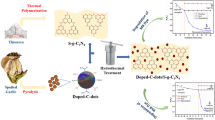Abstract
In contemporary research, semiconductor composite materials, i.e., combination of different semiconductor materials, play an important role in extracting needful energy from existing renewable energy forms. For example, “heterostructure” composite assemblies facilitate faster charge carrier transport and therefore improve the efficiency of the electro-/photoelectrochemical processes/devices due to synergistic interaction and synchronized charge transport across material interfaces that have formed in composite assembly. Herein, we report type-I heterostructure consists of TiO2 and Fe2O3 for crystal violet dye degradation and water splitting studies via electrochemical route. The rationale in choosing the above materials (TiO2, Fe2O3) in the present study will not only account stability, nontoxicity, and high oxidation power but also facilitate the fast charge carrier movements due to proper band edge alignments. Synthesized TiO2, Fe2O3, and TiO2/Fe2O3 nanoparticle assemblies were fabricated as electrodes on titanium (Ti) and indium tin oxide (ITO) substrates and used as anode in electrochemical analysis. Complete decolorization was achieved with all the fabricated electrodes and higher rate of degradation was achieved with composite electrode (Ti/TiO2/Fe2O3) than individuals (bare Ti, Ti/TiO2, Ti/Fe2O3). Further, the same composite electrode shows better performance toward electrochemical water splitting in comparison with individual electrodes.










Similar content being viewed by others
References
W. Li, D. Li, S. Meng, W. Chen, X. Fu, Y. Shao, Environ. Sci. Technol. 45, 2987–2993 (2011)
E. Chatzisymeon, N.P. Xekoukoulotakis, A. Coz, N. Kalogerakis, D. Mantzavinos, J. Hazard Mater. B 137, 998–1000 (2006)
P. Kariyajjanavar, J. Narayana, Y.A. Nayaka, M. Umanaik, Port. Electrochim. Acta 28(4), 265–277 (2010)
N. Bensalaha, M.A. Quiroz Alfaro, C.A. Martínez-Huitle, Chem. Eng. J. 149, 348–352 (2009)
M. Jović, D. Stanković, D. Manojlović, I. Anđelković, A. Milić, B. Dojčinović, G. Roglić, Int. J. Electrochem. Sci. 8, 168–183 (2013)
S. Shukla, M.A. Oturan, Environ. Chem. Lett. 13(2), 157–172 (2015)
C. Nasr, K. Vinodgopal, L. Fisher, S. Hotchandani, A.K. Chattopadhyay, P.V. Kamat, J. Phys. Chem. 100(20), 8436–8442 (1996)
Lumei He, Liqiang Jing, Yunbo Luan, Lei Wang, Fu Honggang, ACS Catal. 4, 990–998 (2014)
A.K. Patra, A. Dutta, A. Bhaumik, ACS Appl. Mater. Interfaces 4, 5022–5028 (2012)
J. Tushar, K. Manjusha, D. Pravarthana, W. Ramadan, P. Thakur, J. Nanosci. Nanotechnol. 12(2), 928–936 (2012)
D.K. Behara, A.K. Ummireddi, V. Aragonda, P.K. Gupta, R.G. Pala, S. Sivakumar, Phys. Chem. Chem. Phys. 18, 8364–8377 (2016)
S.G. Kumar, L.G. Devi, J. Phys. Chem. A 115, 13211–13241 (2011)
A. Socha, E. Sochocka, R. Podsiadly, J. Sokolowska, Color. Technol. 122, 207–212 (2006)
D.K. Behara, G.P. Sharma, A.P. Upadhyay, M. Gyanprakash, R.G. Pala, S. Sivakumar, Chem. Eng. Sci. 154, 150–169 (2016)
S. Bagheri, K.G. Chandrappa, S.B.A. Hamid, Res. J. Chem. Sci. 3(7), 62–68 (2013)
B. Palanisamy, C.M. Babu, B. Sundaravel, S. Anandan, V. Murugesan, J. Hazard Mater. 252–253, 233–242 (2013)
M. Jović, D. Stanković, D. Manojlović, I. Anđelković, A. Milić, B. Dojčinović, G. Roglić, Int. J. Electrochem. Sci. 8, 168–183 (2013)
A. Amalraj, A. Pius, J. Chem. Appl. Biochem. 1(1), 105 (2014)
S.K. Sahoo, K. Agarwal, A.K. Singh, B.G. Polke, K.C. Raha, Int. J. Eng. Sci. Technol. 2(8), 118–126 (2010)
H.-J. Fan, S.-T. Huang, W.-H. Chung, J.-L. Jan, W.-Y. Lin, C.-C. Chen, J. Hazard Mater. 171, 1032–1044 (2009)
S.D. Richardson, Anal. Chem. 80, 4373–4402 (2008)
S. Singh, V.C. Srivastava, I.D. Mall, J. Phys. Chem. C 117, 15229–15240 (2013)
Y.-H.B. Liao, J.X. Wang, J.S. Lin, W.-Y. Lin, C.-C. Chen, Catal. Today 174(1), 148–159 (2011)
H.-J. Fan, S.-T. Huang, W.-H. Chung, J.-L. Jan, W.-Y. Lin, C.-C. Chen, J. Hazard Mater. 15, 1032–1044 (2009)
Palukuru PS, Vishnu Priya N, Devangam A, and Behara DK, Iran. J. Chem. Chem. Eng. (in press)
Acknowledgements
We thank University Grants Commission (UGC XII Plan/2016-17), Govt. of India, for supporting this work.
Funding
This work was carried with funds from UGC XII plan funds and University Development Funds (UDF) of JNT University, Ananthapur (AP).
Author information
Authors and Affiliations
Corresponding author
Ethics declarations
Conflict of interest
The authors declare that they have no conflict of interest.
Additional information
Publisher's Note
Springer Nature remains neutral with regard to jurisdictional claims in published maps and institutional affiliations.
Rights and permissions
About this article
Cite this article
Behara, D.K., Mukkara, S.M. & Jalajakshi, T. TiO2/Fe2O3: Type-I Heterostructures for Electrochemical Dye Degradation/Water Splitting Studies. J. Inst. Eng. India Ser. E 100, 189–198 (2019). https://doi.org/10.1007/s40034-019-00148-y
Received:
Accepted:
Published:
Issue Date:
DOI: https://doi.org/10.1007/s40034-019-00148-y




